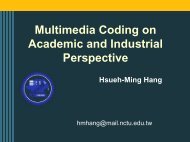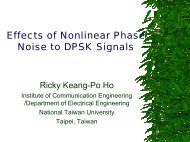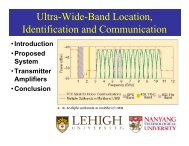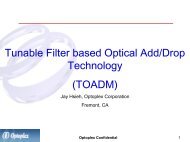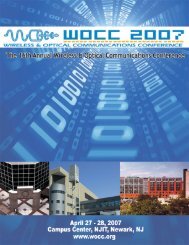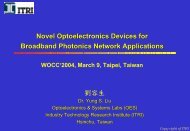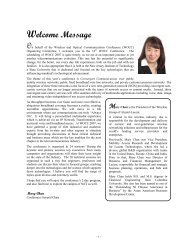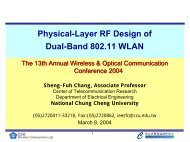Adaptive Demodulation Techniques for Next Generation Software ...
Adaptive Demodulation Techniques for Next Generation Software ...
Adaptive Demodulation Techniques for Next Generation Software ...
You also want an ePaper? Increase the reach of your titles
YUMPU automatically turns print PDFs into web optimized ePapers that Google loves.
Modulation ClassifierFrom: http://www.ottawa.drdc-rddc.gc.ca
1 2 34 5 67 8 90What is Automatic ModulationClassification ?signalFilterA/DIF<strong>Demodulation</strong><strong>Demodulation</strong><strong>Demodulation</strong>DemodulatedsignalLOA non-cooperativecommunicationtechnique which usesstatistical methods toestimate the signalmodulation typesAutomatic ClassificationFilterChannelEqualizerBWCenter Estimation ChannelFrequencyEstimation Symbol RateEstimationEstimationStatistical EstimationModulationRecognition……………………………………… SNREstimation PhaseEstimation
Modulation ClassificationSNR EstimationTemplates BuildingAnalogAnalogPreprocessingAnalogFeatureExtractionPSK/QAMPreprocessingPSK/QAMFeatureExtractionPreprocessed IFCoarse ModulationEstimationDigitalFSK/MSKPreprocessingFSK/MSKFeatureExtractionA non-cooperativecommunication techniquewhich uses statisticalmethods to estimate themodulation type of aunknown signalAnalogModulationEstimationPSK/QAMModulationEstimationFSK/MSKModulationEstimationClassificationDecisionEstimationConfidenceRatingUnknownTypeModulation SchemeClassification ConfidenceModulation ParametersFailure
SDR Applications (1)‣ Overcome channel fading‣ Monitor communication spectrum‣ Remove co-channel interferences1 2 34 5 67 8 901 2 34 5 67 8 90145 2 3678 90145 2 3678 90145 2 3678 90
1 2 34 5 67 8 901 2 34 5 67 8 90SDR Applications (2)Deep Space CommunicationReduce thescheduling andconfigurationburdens ofcommunications52341678 90
Modulation ClassificationOverview
Feature Extraction: Amplitude,Differential Phase, and Frequency•Input: IF•Feather: Amplitude, phase, diff phase, frequency•Statistics: histogram, STD•Classifier: max correlation, decision tree•Reference: Liedtke 1984baud ratedetectorBPFtiming circuittemplatesIFQI/tan -1Δφ2ΔtΔφΔTFreq.STDDeltaphasehistogramcorrelationrecognition treeCWPSK2PSK4PSK8ASK2FSK2( ) 2 ( ) 2 +sqrtAmplitude
Higher-order Trans<strong>for</strong>m of Constellationsc20c21c40c41c42c60c61c62c63c80c81c82c83c84QPSKPSK8PSK16V29-8 and V29-16 constellationsQAM16QAM64QAM32QAM4-12QAM16-16QAM44-20The 4th order constellations
Mr k2 nd order1 st orderHigher-order StatisticalFeaturesPower-law:r 4 ( k )4 th orderdominantpoints4 th order trans<strong>for</strong>mation of QPSKG(Hi| rK) =K M⎧i1 ( i)⎨ ∑ pj( rk)= ⎩M= ⎭ ⎬⎫1 i j 1∏k2 nd orderMoment:mK440= ∑ r ( k)k = 1Cumulant:C240= m40− 3m20QI4 th order trans<strong>for</strong>mation of QAM16
Cumulants vs. SNRs
Cyclic Spectral AnalysisBasebandRaxx*Time varying autocorrelation1 T / 2( τ ) = lim→∞ ∫ R * ( t,tT − T / 2 xxTSaxx*( f )*{*x(t)x ( )}* ( t,t + τ ) = E t + τCyclic autocorrelationSpectrum correlation density+ τ ) e− j 2πat∫ ∞ a − j 2 τ= τπ fR ( ) e dτ−∞xxdtR xxDecision Templates•Input: IF•Features: cycle frequencies•Reference: Menguc, 2004Cycle FreqTheoretical spectrum correlation magnitudeGardner and Spooner 1992
BasebandFeature Classification: MaximumLikelihood (ALRT)TemplatesPDF BPSKPDF QPSKPDF 8PSKK∏k = 1K∏k = 1K∏k = 1(.)(.)(.)l( H | r(k))BPSKl( H | r(k))QPSKl( H8 | r(k))PSKMAXBPSKModulationScheme• Input: baseband• Feature: Complex envelop• Classifier: maximum likelihood• References: Polydoros andKim 1995unknownQPSK8PSK
ALRT1M i∑p( i)jMi j=1( i)p j( rk)Feature Classification: HistogramCorrelation( r )k1M i∑p( i)jMi j=1( r )kG ( Hp( i)ji( r| rk)KKM⎧i1 ( i )) = ∏ ⎨ ∑ pj( rk)= ⎩ = ⎭ ⎬⎫k 1 Mi j 1⎧( i)2⎫1 ⎪ rk− b ( j)⎪exp ⎨−2⎬2πσ⎪ 2σ⎩⎪⎭=2QuantizeHIST(i )p q(i )p qL(H | r ) =iKK∑k = 1log p( i)( r ) =kQQ( i)∑∑logp ( rk) ←∑q= 1 k∈Ωq k=1log p( i)qD( i)q(i )D q• Input: baseband/IF• Feature: frequency/diff phase• Classifier: max correlation• References: Liedtke 1984
Research on CommercialApplications
Research on <strong>Adaptive</strong> ModulationBased on SDR - Cooperative‣ Maintain a constent BER by varying modulation schemes‣ Modulation schemes: QPSK, 16QAM, and 64QAM‣ Data frame based modulation recognition‣ A pilot symbol is used in <strong>for</strong>ward channel‣ Reference: Jain, P.; Buehrer, R.M, “Implementation of adaptive modulation on the Sunrisesoftware radio,” The proceedings of the 45th Midwest Symposium on Circuits and Systems,Volume: 3 , 4-7 Aug 2002. Pages:III-405 - III-408TransmitterPilotDATASlow FlatFadingChannelsPilotDATAReceiverPilotDataFeed BackChannel
Why Applying Non-cooperative<strong>Demodulation</strong>‣ Environment limitation and restriction‣ Elimination of the signal overhead in<strong>for</strong>mation‣ Attractive <strong>for</strong> packet data servicesRFAir-interfacePreprocessingIFDelayerChooseDemodulatorDemodDataoutputModulationRecognitionPreprocessingModulationRecognition
Deference Between Military andCommercial Applications. .SIGINT SDR .Real time classification demodulationSNR low highCandidates unlimited limitedQoS friend / foe packet lossPulse shape unknown knownBandwidth unknown knownBaud rate unknown knownBlindness more less
Assume:‣ Equally likely‣ Symmetrical QAM/PSKPurpose:‣ Reduce the processing timeIssues:Research of Nolan et al.Reduce Form Constellation‣ Low utilization of availablein<strong>for</strong>mation‣ May need longer data length <strong>for</strong>randomnessQConstellation <strong>for</strong> QPSKQReduced <strong>for</strong>m constellationII
<strong>Adaptive</strong> Receiver – Ishii et al.‣ Automatically recognize BPSK, QPSK, 8PSK, pi/4QPSK,16QAM, FSK, MSK, GMSK, AM, FM, CW, and SSB usingdecision tree <strong>for</strong> spectrum, variance, and baud detectionanalysis.ThresholdsTransmitter•SpectrumDecisiontreeRFBPFIF•Envelope•Baud•AmplitudeModulationEstimationOSC•Phase<strong>Demodulation</strong>Dataoutput
Blind Modulation EstimationUmebayshi et al.‣ Automatically recognize BPSK, QPSK, 8PSK, and 16QAM usingamplitude and differential phase variances. Channel gainestimation is discussed (2000).‣ Automatically recognize BPSK, QPSK, and 8PSK usingTransmitter differential phase and maximum likelihood test.RFBPFIF<strong>Demodulation</strong>DataoutOSCNoise VarianceEstimationMaximum LikelihoodModulation Estimation
Research of Menguc and Jondral (1)Air Interface Identification <strong>for</strong> SDRIdentify (Verify?)‣ TDMA-GMSK‣ OFDM-PSK/QAM‣ CDMA-QPSKTransmitterRF•DetermineNumber ofInterfaces•EstimateCarrier andBWPreprocessingBase bandCalculateCyclicAutocorrelation<strong>Demodulation</strong>RecognizeAir InterfacesLikelihoodTestDataoutputThreshold
Research of Menguc and Jondral (2)Magnitude Plot of the Cyclic AutocorrelationEstimationsIssues‣ Processing speed‣ Need universal front endGMSK OFDM CDMA* O. Menguc, “Air interface identification <strong>for</strong> software radio systems,” Ph.D. Dissertation, University of Fridericiana Karlsruhe, Nov. 30, 2004.
Research of Simon and Divsalar (1)Data Format classification <strong>for</strong> SDR•Discriminate NRZ andManchester code•Reduce complexity•Extend to non-coherent caseUse two curves approximateln cosh(x) in order to simplifythe ML computationsmallK −1∑n=0−1⎛2 2Pln cosh⎜r⎝ N0k , NRZ⎞⎟
Research of Simon and Divsalar (2)Reduced Complexity ML ImplementationBasebandDataSNREstimation
Other Research Results on ModulationClassification Based on SDR‣ Gu et al. “Channelized receiver plat<strong>for</strong>m of SDR based onFPGAs, Proceedings of The 5 th IEEE International conferenceon ASIC, Vol.2, Oct. 2003, pp.840-843.‣ Yang, “An enhanced SOFM method <strong>for</strong> automatic recognitionand identification of digital modulations,” Proceedings of the 2 ndIEEE International Workshop on Electronic Design, Test andApplications (DELTA’04), Jan. 2004, pp.174-179.‣ Ko et al. “Modulation type classification Method using wavelettrans<strong>for</strong>m <strong>for</strong> adaptive demodulator,” Proceedings of 2004International Symposium on Intelligent Signal processing andCommunication System, Vol.46, Oct. 1995, pp.211-222.‣ Hooftand Darwish, “A reconfigurable software digital radioarchitecture <strong>for</strong> electronic signal interception, identification,communication and jamming,” COTS Joural, April 2002, pp.31-35.
RF signalNoise PowerEstimationQuantization andAddress MappingNormalizationLook UpTableDecisionProcessConfidenceCheckEstimated ModulationSchemeChoose DemodulatorBandPassFilterPulse Timing andMatched FilteringDelayer<strong>Demodulation</strong>ProcessReal-timeDataOutputLocalOscillatorCarrier and CarrierPhase Tracking
Summary‣ <strong>Adaptive</strong> modulation is not only an importantin<strong>for</strong>mation warfare practice but also an effective toolto maximize the data capacity and minimize thetransmission error in SDR applications.‣ Automated modulation classification is a solution inhandling the non-cooperative communicationproblem <strong>for</strong> SDR.‣ Blind estimation of modulation parameters such ascenter frequency offset, carrier phase, pulse shape,symbol rate, and bandwidth is critical to therobustness of modulation classification.‣ A good modulation classifier should be able toidentify modulation scheme fast and robust.
Future Work‣ Faster estimator‣ Shorter data length‣ Lower SNR‣ Better channel estimation‣ Better QoS




